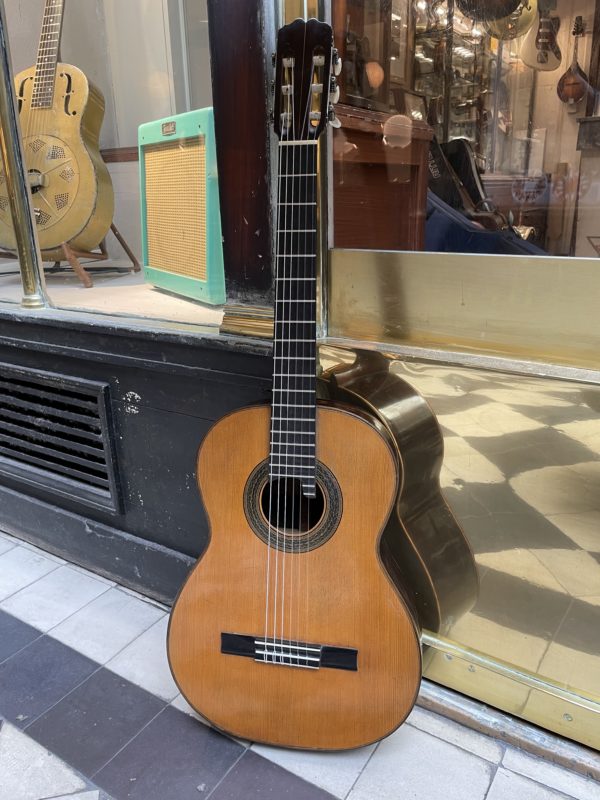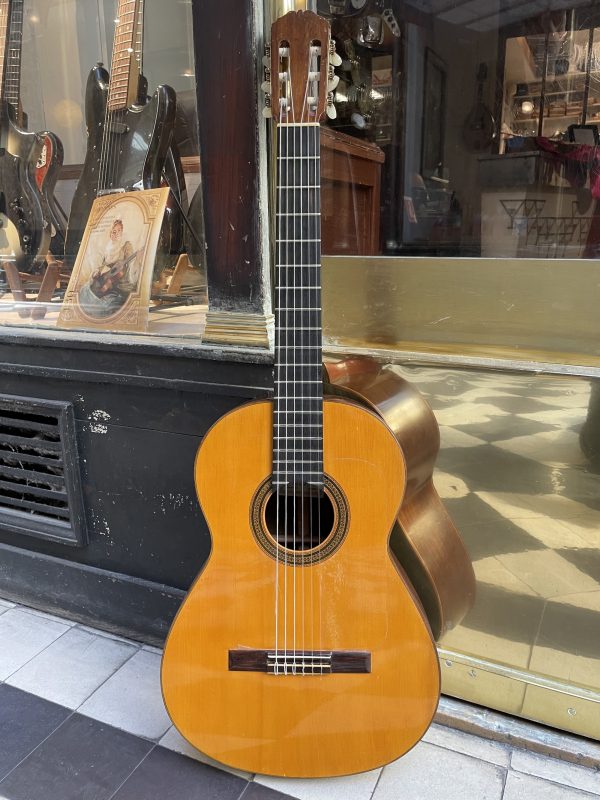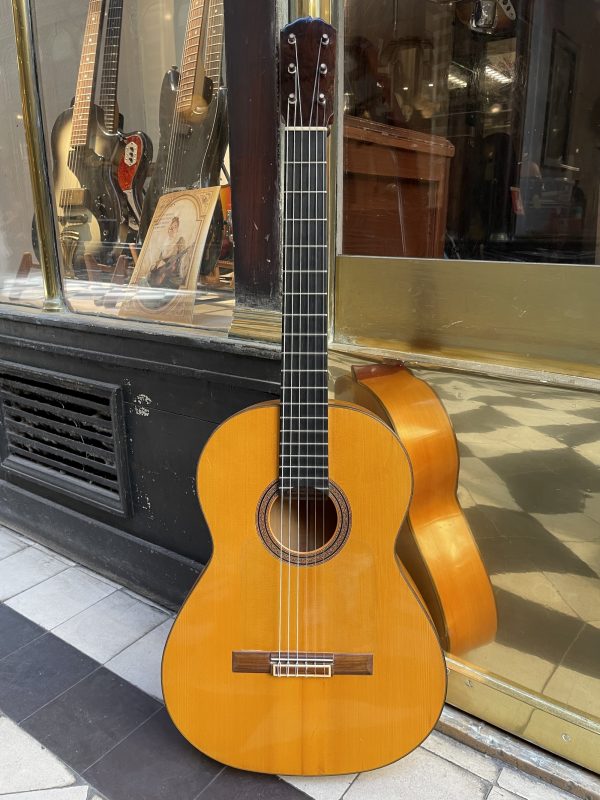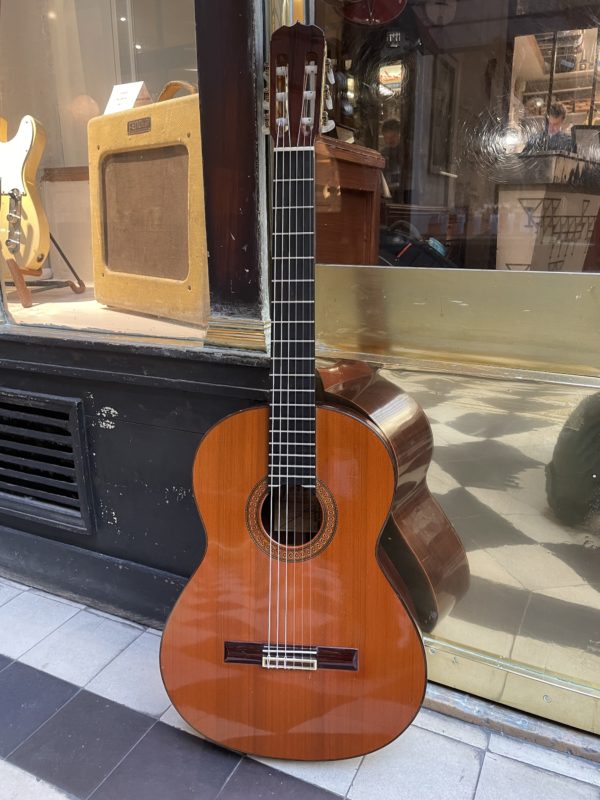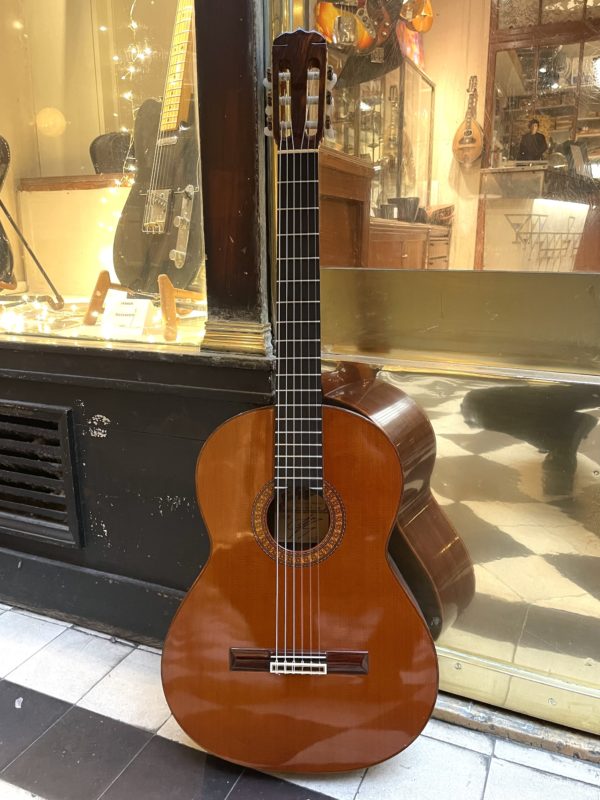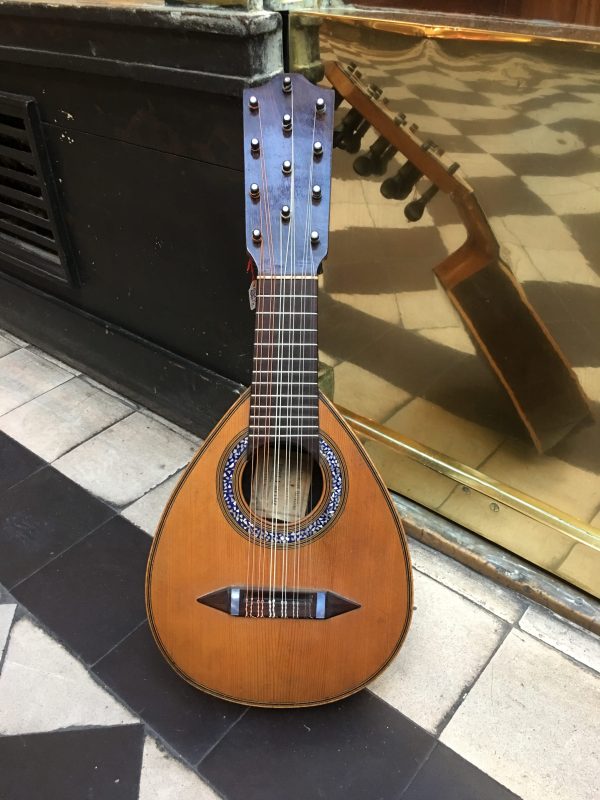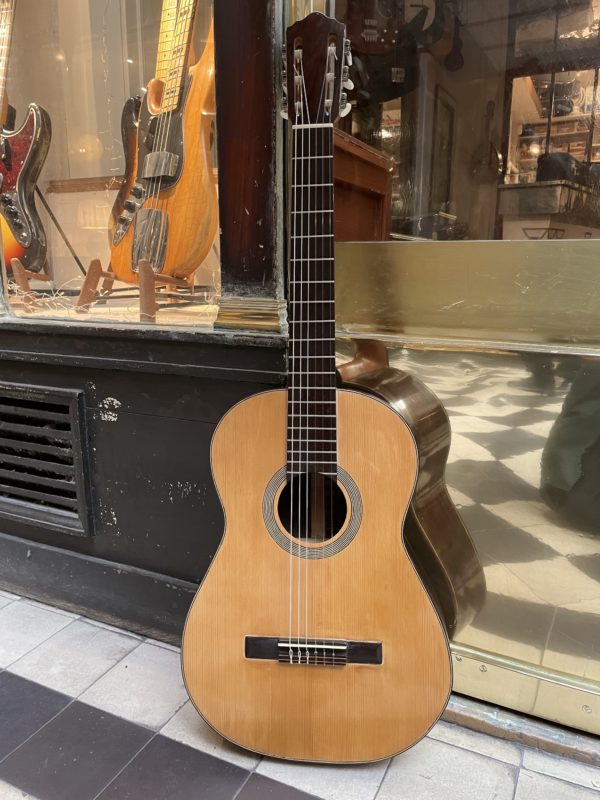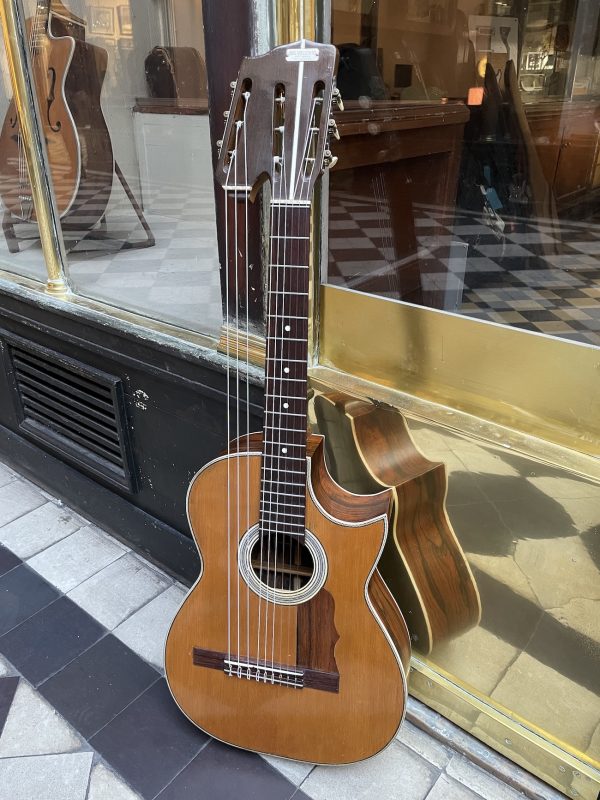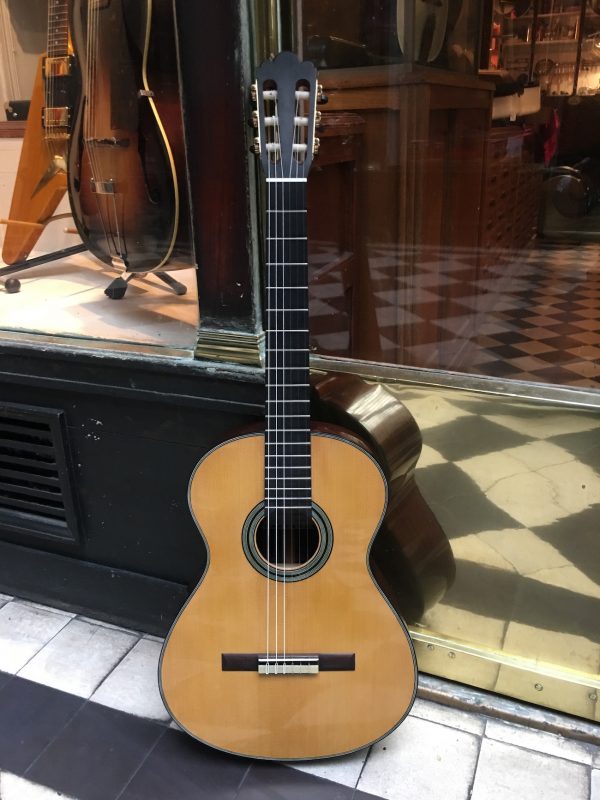Classical
c.1957 DEL VECCHIO HARP-GUITAR
THE CLASSICAL GUITAR
Before the classical guitar with gut strings – then nylon as we know it today – became a concert instrument in itself, as valuable as other classical recital instruments such as the piano, the violin or the cello and even the lute, it remained a secondary musical instrument for a long time, which only enjoyed very gradual, even belated success. On the one hand, because its low sound volume made it a solitary instrument – at best for a living room – and a poor orchestral companion, on the other hand, because the practices and repertoires with which it was associated were not necessarily the most considered. It was often downgraded to the rank of an accompaniment instrument for popular music or perceived as a sort of concert instrument for the poor, if not for a woman or a romantic pre-dandy. However, it is within these limits that a good part of the hegemony of this polyphonic outsider resides: in fact, whatever the era and the context, it has been able to adapt to the musical idioms it has encountered and integrate all their repertoires, and it is thanks to some technical developments in Spain that the guitar will finally show the world what she is really capable of.
If we look far back, all guitars have a distant ancestor, suggested by a Hittite bas-relief from Turkey which foreshadows both the guitarra latina of European origin and the guitarra morisca from the Middle East, both present from the 11th century in Spain.
The guitarra morisca, mounted with steel strings, sings along with some virelais of the poet and musician of the 14th century Guillaume de Machaut (1300-1377), the inventor of the love song as worldly as it is courteous. He mentions it in his text The Capture of Alexandria under the name of guiterne mordache. With the leuïs – lutes or oud’ in Arabic -, it is towards this “Moorish guitar” that he will orient his choice. If the leuïs are at the origin of the family of Western Renaissance and Baroque lutes, the “morache” or “saracenic guitar” is directly linked to the future Portuguese viola as well as to the Italian chitarra battente, the practice of which would be eclipsed over the course of the 18th century in favor of its “Latin” baroque cousin with five courses of strings.
The guitarra latina of European descent seems to come from citoles and other chordophones most often fitted with gut strings. The vihuela de mano of the 16th century, then the baroque guitar, are its direct heirs. The latter will have to wait until the last third of the 18th century in Italy to know the assembly in six simple strings and the contemporary tuning. Then spread all over Europe and become romantic in this form, the “Latin guitar” in evolution will wait nearly a century to fix its “classical Spanish” form and become the ancestor of all modern nylon-string lutheries.
Thus, if Robert de Visée (1650-1725) was the guitar teacher of the rather assiduous pupil that was Louis XIV (1638-1715) – yes, the “Roi Soleil” himself was a fellowguitarist -, and insofar as this time was that of the “Great Classics” Corneille, Racine and even the comic Molière, it took a long time for the guitar to become a so-called “classic” musical instrument, i.e. to be adapted to the interpretation of scholar repertoires and secular liturgical music that constitute this style thus defined. And so it was only in the last third of the 19th century in Spain that the guitar was extracted from its own and corporate compositions – from its very rich folkloric and even romantic repertoire – to open up to the world of classical interpretation on an instrument almost entirely redesigned by Antonio de Torres (1817-1892), whose creative genius can be compared with that of Orville Gibson (1856-1918) in the field of the steel-string guitar.
Antonio de Torres, understanding that the soundboard of the guitar is the centerpiece of the instrument, systematizes the use of bracing in a symmetrical fan, already existing of course, but giving it more effect by spreading it to a wider surface of the top. The romantic guitar’s tiny sides made way with him! To fully endorse the fact that the soundboard is the heart of the problem of timbre and dynamics of the guitar, he goes so far as to experiment with his soundboards on a guitar with cardboard sides, just to highlight only the effect of the top on the overall sound – a research and development system that we can at this time compare to that of Leo Fender’s “log” (1909-1991), a beam stretched with strings on which he tested all his new pickup designs. Like a Gibson or a Fender, Torres’ talent more or less swept away all the rest of gut-string guitar making, first in Spain, then everywhere in the world where all the makers will receive and adapt his new concepts. The Torres workshop first saw the light in Seville between 1852 and 1870, then in Almeria from 1871 to 1893, the second period when the guitars will henceforth be numbered. The major contribution of Antonio de Torres, in addition to an increased sonic projection, is above all a quality of sound never heard before with a great definition of timbre, an extended clear and warm sound register, an unprecedented balance between bass and treble ranges.
It is precisely in Seville that the meeting between Antonio de Torres and the “Father of the Church” of all the guitar adventures to come takes place, all styles and continents combined, the words are weighed here, the man in question here is the immense Francisco Tárrega (1852-1909). Francisco is seventeen years old and, with his Torres guitar in hand, he is on the way to becoming not only an absolute virtuoso – nicknamed the Sarasate of the guitar – but also a fine and inspired composer who is at the origin of the structuring of classical guitar playing and, even beyond, not only of the resonance of the recital instrument throughout the world but also of the diffusion of its aura. In other words, if we take a somewhat absurd but quite congruent shortcut, no Jimi Hendrix without Francisco Tárrega! That’s it.
Thus, as contradictory and comical as it may seem, it is on a modern guitar by Antonio de Torres, of new shape and design, that the so-called “classical” repertoire finally becomes accessible to the instrument. If Francisco Tárrega is the pioneer, it is still necessary to count on some important characters to bring the voice of the classical guitar to the four corners of the globe: let us name Emilio Pujol (1886-1980), pupil of Tárrega, himself an excellent musician and teacher who will adapt hundreds of classical pieces for the guitar; then the Barcelonian Miguel Llobet Solés (1878-1938) to whom we owe the first classical guitar recordings and perhaps some lessons given to the young Andres Segovia (1893-1987) who can be considered the very first concert performer world-class classical guitar. This absolute Master of the classical guitar will adapt J.S. Bach (1685-1750) and will give in 1935 a premiere of the “Chaconne de la Partita n°2”, a piece renowned in the classical repertoire as being particularly difficult to execute. At the end of the post-war period, Andres Segovia was also at the origin of the replacement of archaic gut strings by nylon strings.
When we talk about classical guitar, we cannot overlook South America, which has carried, and still carries, among the most influential and talented so-called classical guitarists. A special mention for the multi-instrumentalist and composer Heitor Villa-Lobos (1887-1959), for Agustín Barrios Mangoré (1885-1944) and Antonio Lauro (1917-1986). All three have this post-romantic eloquence and this hyper-melodic inventiveness of an abundant musicality specific to musicians from South America, and we can without exaggeration say that the great modern that was Baden Powell (1937-2000) and the stunning contemporary Yamandu Costa (1980) are worthy heirs.
In Europe, historical concert performers from the glorious period of the classical guitar, which is between the 1940s and 1990s, are plentiful. Among those who won the approval of the general public are Narciso Yepes (1927-1987) who unearthed the anonymous romance “Jeux Interdits” attributed to the romantic guitar virtuoso Fernando Sor (1778-1839), the British Julian Bream (1933-2020) whose idol was Django Reinhardt (1910-1953) and undoubtedly the freest verve of the classical genre, the duo Ida Presti (1924-1967) and Alexandre Lagoya (1929-1999) dominated by the exceptional talent of Ida, John Williams (1941) often considered a prince second only to the King Segovia, David Russell (1953) whose recording of the complete version of Francisco Tárrega is an unequaled reference, Roberto Aussel (1954-), Argentinian living in France and for whom Astor Piazzolla (1921-1992) wrote some pieces for classical guitar.
Classical guitar makers around the world are just as numerous and no less talented. If we exclude the mass industry, which offers relative quality depending on its origin, Spain remains a safe bet in this respect, classical guitar lutherie remains above all a matter of craftsmen. Like all of the luthiers in the quartet who adapt the archetype of the Stradivarius violin at will, all the classical guitar luthiers base their work, research and development, around the concept of Antonio de Torres. The classical guitar is today itself an archetype of which we can cite here some names of internationally renowned makers who participated in its myth: the French Robert Bouchet (1898-1996) and Daniel Friederich (1932-2020), the entire Spanish Ramirez dynasty, with in particular José Ramirez II (1885-1957), the German Herman Hauser (1882-1952) who was for a long time the choice of the great Andres Segovia, José Luis Romanillos (1932), the Englishman David Rubio (1934-2000), the Japanese Masura Kohno (1926-1998), and the Australian Greg Smallman (1947-) at the origin of the lattice bracings, as innovative as they are debated.


